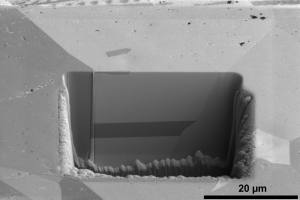A new Emmy Noether Junior Research Group at the Institute for Applied Materials of Karlsruhe Institute of Technology (KIT) focuses on how the microstructure of materials changes as a result of friction. The research group of Dr. Christian Greiner analyzes structural modifications in friction contact using model materials like copper and steel. Wear of the material and energy consumption might be minimized by a specific adjustment of the microstructure. This is relevant to many applications, ranging from combustion engines to wind power plants.
Whenever components are in contact and move relative to each other, friction plays a role. This so-called tribological loading occurs in bearings, guide systems, seals, and gears in pumps, engines, generators, and other machines. Friction causes wear of material and increases energy consumption. “To minimize friction and wear, structural properties of the material have to be adjusted specifically,” explains material researcher Dr. Christian Greiner from the Institute for Applied Materials – Reliability of Components and Systems (IAM-ZBS) of KIT.
Christian Greiner heads the Emmy Noether Junior Research Group “Scale Effects and Microstructure Development of Textured Metal Surfaces in Reversing Friction Contact” that is to start on January 01, 2013. Under the Emmy Noether program, the German Research Foundation (DFG) grants excellent young researchers early scientific autonomy. The DFG will fund the group with a total amount of EUR 1.4 million over a duration of five years.
According to Greiner, the microscopic structure of a material decisively determines its properties. However, little is known about this relationship for solids in friction contact. The Junior Research Group at IAM-ZBS will study the development of the inner material structure under tribological loading by means of a fundamental research approach. In model experiments, the scientists will analyze the modification of the microstructure in the highly loaded contact zone of materials like highly pure copper and C85 steel, i.e. steel that contains 0.85% of carbon in addition to iron. Then, they will study how these modifications affect the tribological properties.
The KIT researchers will concentrate on reversing friction contact resulting from movement in forward and backward direction. In the dead centers, at the points where the direction changes, sliding speed is temporarily zero, such that even in case of contacts with a lubricant, the lubricating film is lacking and the solids are in direct contact with each other. “These dead centers are of particular interest to fundamental research as well as to industry,” says Christian Greiner. “Here, wear of the cylinders of combustion engines is highest.” Greiner points out that structural modifications occur in the material below the surface prior to wear already.” We have to understand these structural modifications in order to understand wear. For this purpose, we commissioned a specially developed new high-resolution dual-beam ion microscope in late October.
”The scientists will structure the contact surfaces by 3D laser texturing in order to vary friction power density and study its influence on the microstructure. Based on the results of their experiments, they will generate a model for tribological loading. The Emmy Noether Junior Research Group will cooperate with the Microtribology Center µTC, a joint initiative of the Fraunhofer Institute for Materials Mechanics IWM and KIT.
In close partnership with society, KIT develops solutions for urgent challenges – from climate change, energy transition and sustainable use of natural resources to artificial intelligence, sovereignty and an aging population. As The University in the Helmholtz Association, KIT unites scientific excellence from insight to application-driven research under one roof – and is thus in a unique position to drive this transformation. As a University of Excellence, KIT offers its more than 10,000 employees and 22,800 students outstanding opportunities to shape a sustainable and resilient future. KIT – Science for Impact.

